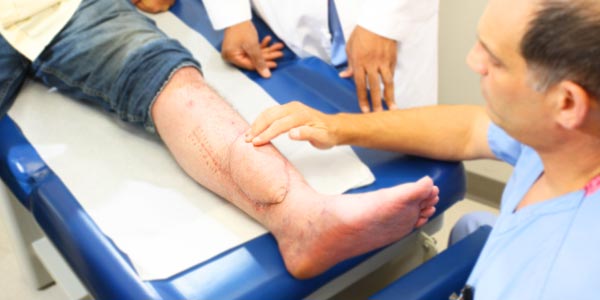- Home
- Patient Care
- Services
- Hand & Microsurgery
- Overview
- Reconstructive Microsurgery
Reconstructive Microsurgery

 Download brochure PDF
Download brochure PDF
Overview
Reconstructive microsurgery is a general term that is used to describe the surgical treatment of patients with complex injuries involving skin, muscle, tendons, nerve, and bone, where sections of living skin, muscle and bone are transplanted from one part of the body to another.
This technique allows the surgeon to use the injured patient’s own bone or tissue to cover a wound, rebuild an arm or a leg, or restore lost function. The key to this technically complicated procedure is the careful microscopic reattachment of the tiny blood vessels to the tissues being transplanted so that they continue to live and function in their new location.
Diagnosis
When is reconstructive microsurgery needed?
- Severe traumatic injury
- Surgery to remove cancerous tumors
- Severe infections
Reconstructive microsurgery may be required for a variety of reasons, including a wound being too large to be surgically closed, or where many different types of tissue (such as skin and muscle or muscle and bone) are needed. Reconstructive microsurgery can be essential in saving an arm or a leg from amputation, and also in restoring function to a damaged arm or leg.
Treatment
When is reconstructive microsurgery performed?
Microvascular reconstructive surgery is an inpatient procedure performed at Barnes-Jewish Hospital. In the specialized nursing units of Barnes-Jewish Hospital, highly-trained nursing staff monitor the health of both the patient and the transplanted skin, muscle or bone by means of a variety of technologies that allow for quick identification and treatment of any post-operative challenges that may occur.
Recovery and Outcomes
The goals of reconstructive microsurgery are:
- Limb preservation
- Restoring limb function
For the leg, this involves preserving weight-bearing function, and for the arm, this includes motion, strength and the ability to position the hand in three dimensions. Our treatment of the patient does not stop when the patient leaves the hospital, but when the patient’s function is maximized.
After the patient is discharged from the hospital rehabilitation will begin. The discharge plan may include a stay in a rehabilitation facility, a nursing facility, or a patient may be discharged to their own home, depending on the patient, the injury and the family’s ability to provide needed care.
About Our Team
- Dedicated microsurgical team to evaluate and treat patients coping with these devastating injuries
- Advanced training and highly-skilled surgical expertise for complex microsurgical cases
- Collaborative environment, working closely with our orthopedic trauma and cancer surgeons before, during, and after surgery
- Pre-operative involvement of other physicians and surgeons, radiologists, nurses, social workers and dietitians, serving the patient’s needs from the initial meeting until recovery
- Clear and timely communication with patients and their families throughout the patient’s care
Why Choose Washington University Orthopedics for Reconstructive Microsurgery?
Reconstructive microsurgery requires a delicate level of precision and expertise. Our orthopedic surgeons apply a thorough understanding of the musculoskeletal system, which is an advantage when performing such complex procedures. Our surgeons operate at Barnes-Jewish Hospital, which is nationally recognized as a Level 1 Trauma Center by the American College of Surgeons (ACS). A Level 1 Trauma Center provides the highest level of trauma care, which is crucial for patients in need of reconstructive microsurgery as a result of a severe injury.
More Information